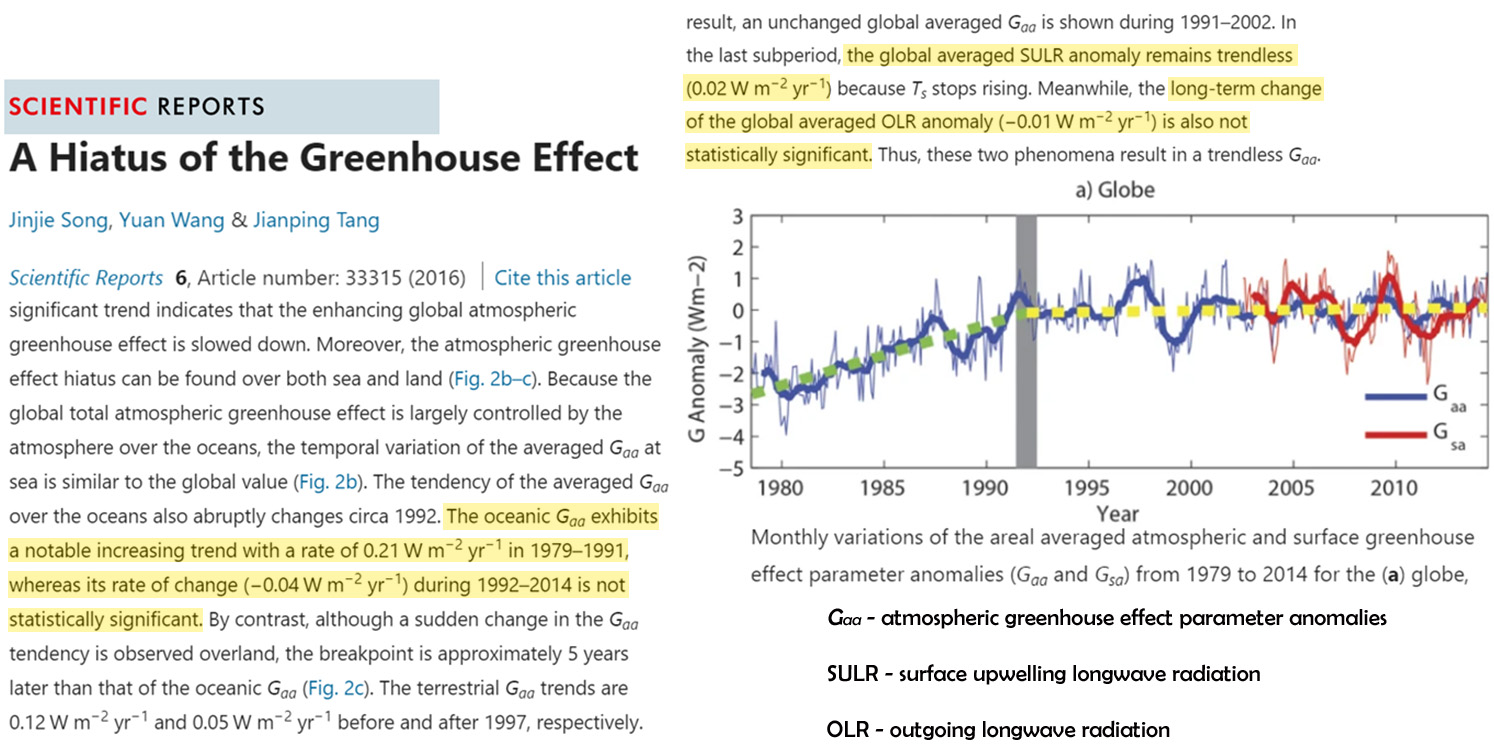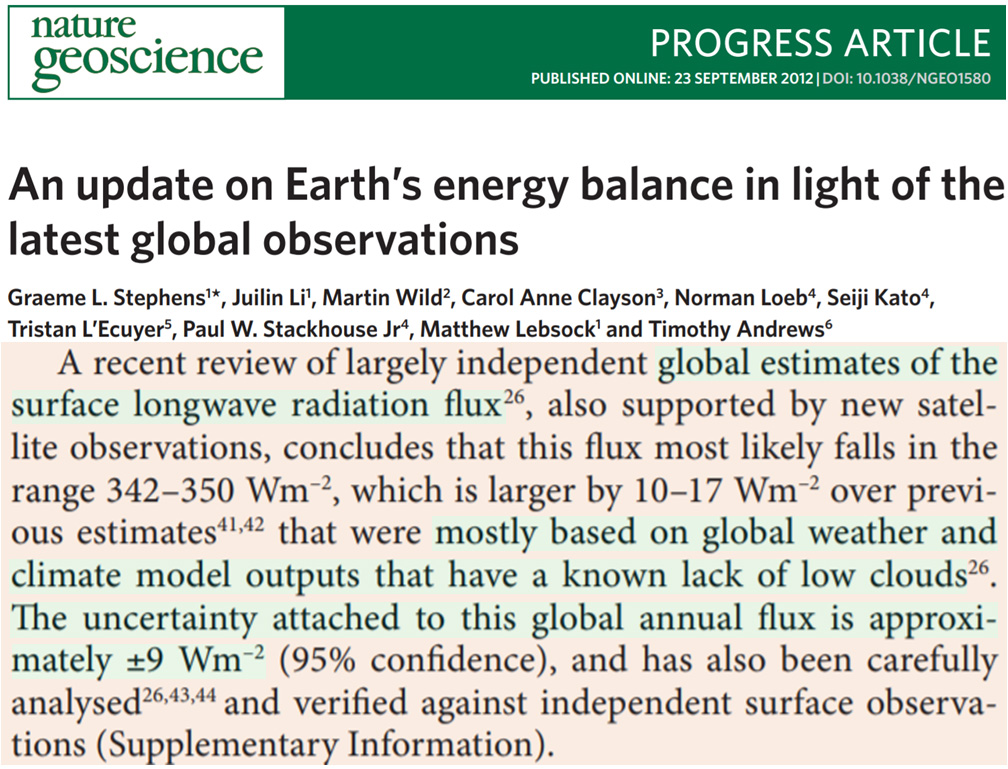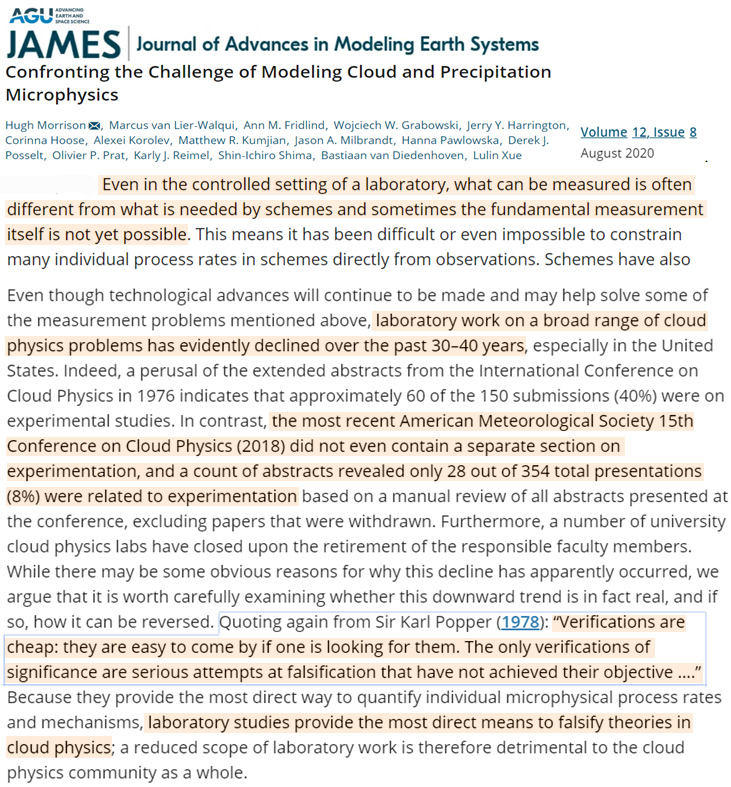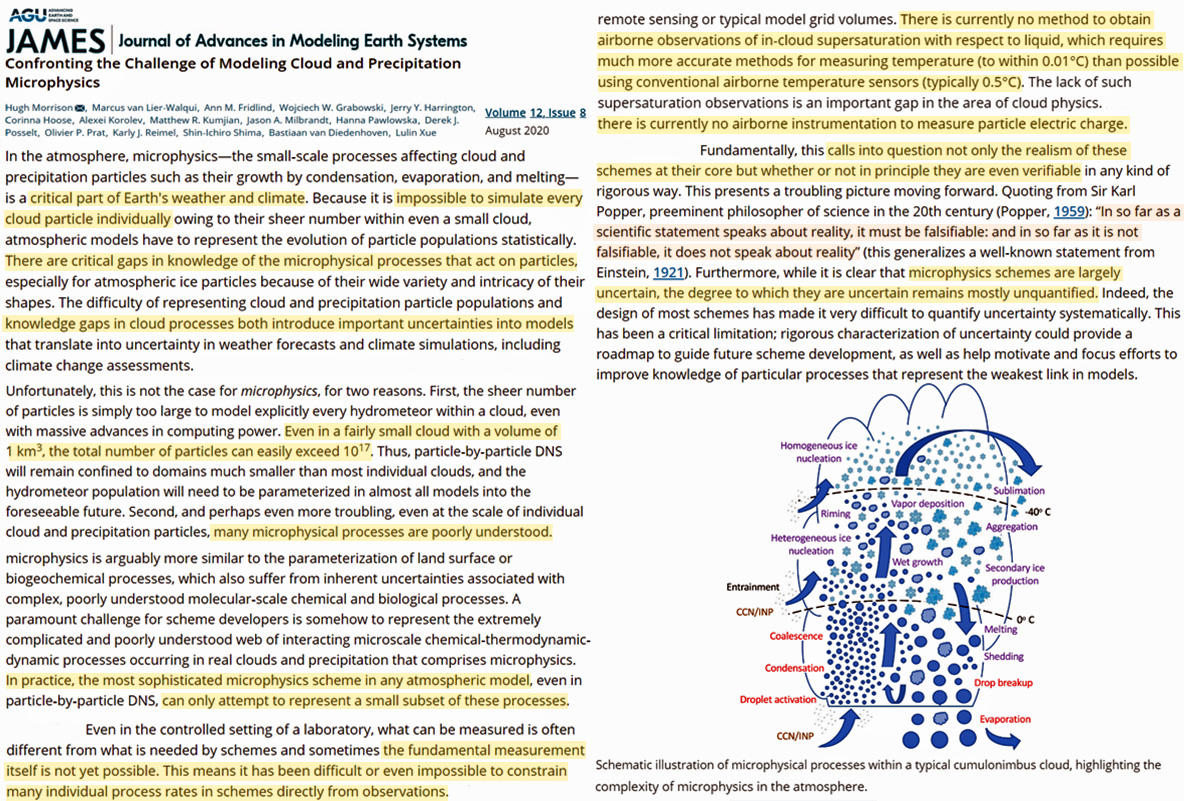Clouds dominate as the driver of changes in the Earth’s radiation budget and climate. A comprehensive new analysis suggests we’re so uncertain about cloud processes and how they affect climate we can’t even quantify our uncertainty.
According to scientists (Song et al., 2016), the total net forcing for Earth’s oceanic atmospheric greenhouse effect (Gaa) during 1992-2014 amounted to -0.04 W/m² per year. In other words, the trend in total longwave forcing had a net negative (cooling) influence during those 22 years despite a 42 ppm increase in CO2. This was primarily due to the downward trend in cloud cover that overwhelmed or “offset” the longwave influence from CO2.

Image Source: Song et al., 2016
Cloud impacts on climate are profound – but so are uncertainties
The influence of clouds profoundly affects Earth’s radiation budget, easily overwhelming CO2’s impact within the greeenhouse effect. This has been acknowledged by scientists for decades.
Despite the magnitude of clouds’ radiative impact on climate, scientists have also pointed out that our limited capacity to observe or measure cloud effects necessarily results in massive uncertainties.
For example, Stephens et al. (2012) estimated the uncertainty in Earth’s annual longwave surface fluxes is ±9 W/m² (~18 W/m²) primarily due to the uncertainties associated with cloud longwave radiation impacts.

Image Source: Stephens et al., 2012
So with a total net greenhouse effect forcing impact of -0.04 W/m² per year (1992-2014) and a longwave surface flux uncertainty of about 18 W/m² per year, the possibility of scientifically affirming the anthropogenic (CO2) signal in climate forcing can effectively be ruled out.
Eschewing laboratory work in cloud microphysics
Instead of embracing the challenge of enhancing our knowledge of critical cloud processes in the laboratory and via experiments, climate scientists are increasingly choosing to neglect cloud impacts and formulate climate models without them.
A new study (Morrison et al., 2020) suggests only 8% of 354 cloud studies in 2018 involved laboratory or experimental work in cloud microphysics.
Without real-world observations and controlled experiments, scientifically falsifying hypotheses becomes nearly impossible. Without falsification, there can be no corroboration.

Image Source: Morrison et al., 2020
Cloud physics challenges in climate modeling
But it gets worse. Morrison et al. (2020) acknowledge cloud microphysics – processes affecting precipitation and evaporation – are a “critical part of the Earth’s weather and climate”. But they further assess:
“[I]t is impossible to simulate every cloud particle.”
“There are critical gaps in knowledge of the microphysical processes that act on particles.”
“[K]nowledge gaps in cloud processes both introduce important uncertainties into models that translate into uncertainty in weather forecasts and climate simuations, including climate change assessments.”
“[I]t has been difficult or even impossible to constrain many individual process rates in schemes directly from observations.”
“There is currently no method to obtain airborne observations of in-cloud supersaturation with respect to liquid, which requires much more accurate methods for measuring temperature (to within 0.01°C) than possible using conventional airborne temperature sensors (typically 0.5°C).”
“[This] calls into question not only the realism of these schemes at their core but whether or not in principle they are even verifiable.”
In other words, we are seriously overestimating the extent to which we can model or even understand the factors affecting weather and climate due to critical observational constraints and knowledge gaps in cloud processes.






(1)
“So with a total net greenhouse effect forcing impact of -0.04 W/m² per year (1992-2014) and a longwave [sic] surface flux uncertainty of about 18 W/m² per year, the possibility of scientifically affirming the anthropogenic (CO2) signal in climate forcing can effectively be ruled out.”
Nice and clear!
(2) At the risk of appearing to be nitpicking:
“Without real-world observations and controlled experiments, scientifically falsififying [sic] hypotheses becomes nearly impossible. Without falsification, there can be no verification.”
I would use the term “corroboration” instead of “verification”, as the latter is associated with the discarded view that science progresses by verifying, i.e. establishing the indubitable truth of certain statements/hypotheses/findings. By contrast, science either refutes or “corroborates” its findings, the latter meaning that what evidence could be found, does not refute the hypothesis, so it can stand as (among) the best version(s) of our conjectural knowledge, for the time being.
Thank you, Georg. I decided to use every one of your editing suggestions. I had used the word “verification” because that’s the word used in the Popper quote.
While I agree with your nitpick in principle, in practice the terms “verification” and “corroboration” are synonymous, i.e., their definitions are too similar to justify one over the other, without some additional qualification that is understood by all to apply to science. If Popper used “verification,” then we already have a problem.
In short, I don’t think that there’s sufficient difference in the definitions to establish with precision the distinction we both agree should be made.
Dear Yonason,
Thank you for your take.
It seems to me that the difference between “verification” and “corroboration” is important, considering that most people think science is about verification (proving an ultimate truth) rather than refutation or corroboration (establishing that disproof/refutation has not been achieved).
Popper is all about that vital distinction between verification and corroboration.
Verificationists of the school of logical positivism provoked one of the most prominent intellectual battles of the subject. They lost as far as the history of sciences goes, but remain in the driver’s seat in the minds of most people.
In fact, the anti-scientific phrase “the science is settled” and the ostracism of “deniers” of global warming conquer easily the minds of verificationists and would never occur to those who understand that science is the business of trying to deny (refute or corroborate but never establish ultimately) the truth of a hypothesis.
Let me add, the initial reasoning of Kenneth Richard and Yonason’s view are clearly based on careful thinking. In the broader context of the quote, Popper seems to juxtapose “verifiability” (which he considers impossible) and “falsifiability”, and uses the term “verification” essentially in the sense of the word “corroboration”.
Thanks, Georg. I wholeheartedly agree to all that.
I don’t see why verify or corroborate can’t be used with reference to the results of experiments that support each other in saying that an aspect of a theory is “verified” or “corroborated” to be false, or that one supports the other in the case of being able to predict the response of a system to whatever variables are tested. In other words, use of either in reference to how experiments support each other is, I think, legitimate. The problem arises when one uses those terms in reference to whatever phenomena is being explored. We can only verify or corroborate our mutual experiences, but never ultimately what is causing them.
If you find a protocol that I can reproduce and achieve the same results, that’s a powerful tool. But it doesn’t ultimately tell you why it works. Too many today, it seems, make the mistake of conflating a protocol for manipulating an aspect of reality, with the reality itself.
Dear Yonason, I’ve had enough occasion to explain my preferences, while I feel that your approach to the matter is equally valid. Thanks for food for thought, especially your mentioning of “a protocol” inspires me to do some further research.
Thanks, Georg. Semantics aside, I think we agree.
Just to be clear, by “protocol,” I just mean an experiment which, if I can repeat it, then I’m corroborating/verifying it’s results. But even then, that still doesn’t settle the science.
An interesting case study I learned about in college involved a dispute between Newton and Goethe. They were two great minds who didn’t think alike.
https://www.sciartmagazine.com/blog/art-versus-science-color-theory-war-between-goethe-and-newton
Fast forward to the 20th century, and we have Ed Land, who added a new twist, based on a fortuitous accident.
http://www.greatreality.com/Color2Color.htm
It seems that there’s always more to learn. And even if there isn’t, it’s healthy to assume there is, because for all we know, there just might be.
https://www.smhi.se/polopoly_fs/1.143989.1548428766!/image/allsack_1983-lastyear.jpg_gen/derivatives/Original_1256px/image/allsack_1983-lastyear.jpg
Thanks, v interesting. Song et al 2016 show that strong La Niñas can push greenhouse warming into reverse. There’s a nice La Niña brewing up now.
NASA says the same- except his assessment is that the modelling is even worse than noted above.
Oddly, this has not been picked up by the MSM…
https://notrickszone.com/2019/08/29/nasa-we-cant-model-clouds-so-climate-models-are-100-times-less-accurate-than-needed-for-projections/
“NASA has conceded that climate models lack the precision required to make climate projections due to the inability to accurately model clouds. “
In other words, we are seriously overestimating the extent to which we can model or even understand the factors affecting weather and climate due to critical observational constraints and knowledge gaps in cloud processes.
Well Kenneth ain’t that is the truth.
Just have a desert blow-up some dust, or a forest vent some VOC into the surrounding atmosphere, or a volcano puff a bit of ash into the air, and bang the calculations miss the mark.
But there’s so much more … clouds hitting a wind shear zone, a sudden but brief blast of anomalously warm or cool wind hit the damp atmosphere.
And there is no real understanding of the energy transfers that go on inside clouds — all that interplay between vapor state and the liquid, all that movement, plus the boundary effects both high and low (pressure shifts bottom to top), sunny side and parts in shadow, windward side, etc., etc.
One of my favorite question for true believers is to ask “exactly how do the models describe how THAT cloud just THERE came into being, how does it describe the way it will evolve, and the nature of it’s dissipation. And please explain how MILLIONS of tons of water is held aloft and moves — where does all that energy come from?
Joni Mitchell summed it up many years ago with her rendition of the totality of knowledge and understanding of clouds in this …
https://m.youtube.com/watch?v=v9j_j-cUwKc
🙂
And we know all about clouds?
Well the UK Met Office admit they don’t.
From https://www.metoffice.gov.uk/weather/learn-about/weather/types-of-weather/clouds/other-clouds/asperitas
Maybe they form after the release of excess tonnage of hubris filled hot air from the global warming collective of dingbats.
[…] Scientists: It’s ‘Impossible’ To Measure Critical Cloud Processes…Observations 1/50th As Acc… […]
[…] Scientists: It’s ‘Impossible’ To Measure Critical Cloud Processes…Observatio… […]
[…] Scientists: It’s ‘Impossible’ To Measure Critical Cloud Processes…Observatio… […]
[…] https://notrickszone.com/2020/08/20/scientists-its-impossible-to-measure-critical-cloud-processes-ob… […]
[…] https://notrickszone.com/2020/08/20/scientists-its-impossible-to-measure-critical-cloud-processes-ob… […]
[…] by K. Richard, August 20, 2020 in NoTricksZone […]